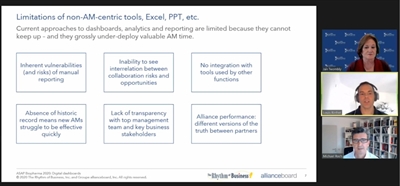Partnering by the Dashboard Light: Digital Platforms Help Organize Fast-Growing Alliance Portfolios
Posted By Jon Lavietes, Wednesday, November 25, 2020
Biopharma alliances have been steadily growing in number and complexity. In the early drug development phases, companies are shifting R&D responsibilities to an increasingly diverse array of CROs, academic institutions, startups, accelerator programs, and institutes. Clinical trials are part of larger programs managed by long-term partners. No longer are pharmaceutical companies confined to selling directly through a salesperson, as digital health alliances have created multiple routes to market and better ways to get data and real-world evidence into the hands of care providers, and have empowered patients to administer self-care.
“It all means new partners, more partners, and new partnering models,” said Jan Twombly, CSAP, president of The Rhythm of Business.
Staying on top of this growing alliance portfolio gets unwieldy using ubiquitous office tools, such as email and Microsoft Office, which normally suffice for a small number of collaborations. Once a certain threshold is reached, alliance managers need a robust, centralized digital solution that can track a multitude of partnerships of all sizes at scale.
At the 2020 ASAP BioPharma Conference, it was up to Michael Roch and Louis Rinfret, chief commercial officer and founder and CEO, respectively, of ASAP partner allianceboard, makers of a comprehensive partner management solution, to show one example of this in their presentation “Designing Your Digital Alliance Management Dashboard.”
Dashboards Help Visualize Success
After Twombly painted a picture of a partnership function growing increasingly complex, she gave way to Rinfret, who listed 10 elements of maintaining a high-functioning alliance practice:
- Strategy
- Scale
- Maturity
- Success Across the Alliance Life Cycle
- Risk Management
- Health Checks and Performance Analysis
- Results
- Organization/People
- Policies and Procedures
- Data Management and Digital Enablement
It is the last of these categories where allianceboard makes its mark from an operational standpoint.
“[An alliance management platform is] the underlying technology that empowers all of the stakeholders that have to work with alliances, whether they are pure traditional alliance managers, people from other business units who aren’t involved somehow in managing alliances, or they are [part of] the extended alliance team—the department stakeholders, your senior leadership, and so on,” said Rinfret.
However, Rinfret made the case that digital alliance management platforms also play a large role in addressing that age-old problem of demonstrating the alliance practice’s value by illuminating its contributions for the rest of the organization to see.
“That’s where we really want to make a contribution in terms of dashboarding, because a lot of the times some of these activities are performed very well but they are not quite as visible as they should be, both internally with your own stakeholders, as well as externally with your partners. That puts a damper on not only how well the alliance management function is recognized but on things like how much support can you get, how quickly can you get this support, and what resources you can obtain,” he said.
Wrong Lane! Dashboard Helps Prevent Misalignment, Misunderstandings
Like similar digital dashboard products and services in other industries, an alliance management portal reduces the amount of administrative time spent updating and formatting spreadsheets and agendas, finding emails, and tracking down people to obtain answers on pivotal issues. Most important, everything anyone within the partner organizations wants to know is centrally stored in a single, accessible repository.
“Not storing your information all in one place, on the other hand, presents serious risks. You don’t have all of your risks, milestones, and deliverables tracked in an orderly, easily accessible, and visualizable way,” said Rinfret. “It becomes difficult to do your planning and management, and it creates misalignment and misunderstandings within the organization.”
Just as important, according to Rinfret, is that dashboards create a “corporate memory” that can help mitigate the loss of domain expertise from personnel turnover that alliances experience over time. Moreover, they make it easier to apply best practices gleaned from other alliances and partners across the portfolio.
“If everything is tracked in a central platform with a full, historical record, it becomes much easier to build that competency,” said Rinfret, who added that dashboards play a role in building the trust that is essential to alliance success because their use reinforces “communications and transparency.”
Analyze This: Key Metrics at Your Fingertips
At the heart of any dashboard software is data and analytics tailored to key audiences. Senior management can pull up financials, risks, upcoming milestones, and key partner events at any time. Alliance management leaders can instantly filter and view alliances by phases, stage of development, and the services being delivered or solutions being created by each partnership. They can understand immediately whether their companies are on track to deliver on their promises to partners and the marketplace, and check the status of new opportunities.
Alliance management platforms also provide templates for governance agendas and automate the process of aggregating critical data in advance of committee meetings, including upcoming milestones, key decisions that need to be made, important events or initiatives, and the roles and responsibilities of each committee member.

